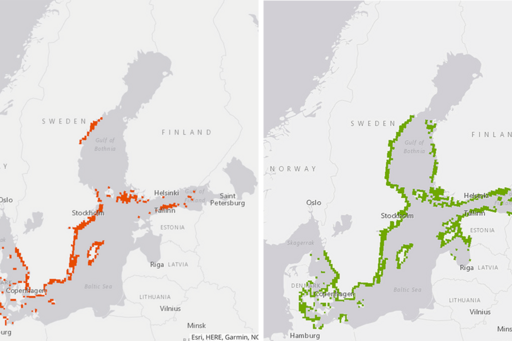Predicting future distributions
The warming and salinity decrease predicted for the Baltic Sea will affect species ranges and might result in loss of marine populations. As a task in BONUS BAMBI, we have predicted future distributions of bladder wrack under the most plausible climate and nutrient loading scenarios.
As shown in the maps below, there will be a dramatic change in the distribution of bladder wrack, mainly due to the expected salinity decrease. Since bladder wrack provides an important habitat for many other species, the impact of this decline could be significant.

Dramatic decline
Our modelling work (see below) predicts that the future distribution of Fucus in the Baltic Sea could shrink up to 30 percent, as compared to the present. The mechanism behind is an impressive southward and westward expansion of low-salinity water. The effect is most notable in the Gulf of Bothnia and the Gulf of Finland, see left map above.
Marginal populations at risk
The loss of suitable habitat for bladder wrack, mainly due to lower salinity, may result in fragmentation and reduced connectivity. As a consequence, the risk for populations to go extinct will be higher. This is especially true for marginal populations, e.g the populations in the Bothnian Sea and in the Gulf of Finland.
Crucial populations may be lost
Bladder wrack in the Bothnian Sea and the Gulf of Finland has evolved to tolerate low salinity. These populations harbour locally adapted genes that can help the species survive in a future Baltic Sea environment with lower salinity. Losing them may lead to an even more severe decline than our model predicts, see below.
Adapted genotypes need to disperse
Our model assumes that, as the salinity decreases in the Baltic, adapted genotypes can disperse into new areas and establish new populations. If not, the future decline could be even more severe. Present (not adapted) populations will probably not cope in the new environmental condition, since they are unlikely to adapt fast enough.
Critical relocation rate of 50 km/decade
We have calculated the rate a locally adapted population needs to relocate in order to "track" a salinity change in the Baltic Sea. For many areas, the rate exceeds 50 kilometers per decade. This may be a critical rate for bladder-wrack, indicating that the loss of this species may be even higher than predicted by our model. There may be management options to facilitate the dispersal of local genotypes, see below.
Management recommendations
- Minimize environmental impact in areas that harbour bladder wrack today, to mitigate the risk of losing populations.
- Protect areas with a predicted future presence, through MPA:s and adequate management plans.
- Enhance the dispersal of adapted genotypes through additional MPA:s in critical areas to overcome connectivity barriers.
- Although not normally advised, consider to translocate individuals from low salinity-adapted populations into areas that face rapid salinity decrease and risk for local extinctions.